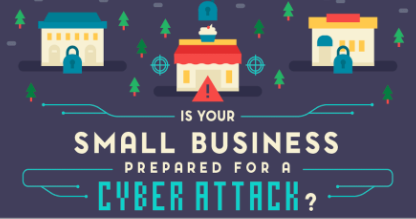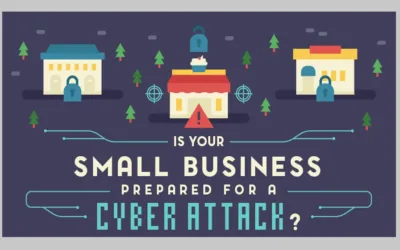If you think that your business is completely protected from inbound cyber attacks, Think again. A study released from the San Diego based cybersecurity firm Cybergc revealed that, more than 30% of US based small businesses have weaker security safeguards in place that can be exploited by bad actors. After scanning for vulnerabilities, in more than 20000 randomly selected US based small businesses, they found that around 1/3 suffered from spoofing while 28 succumb to clickjacking Spoofing occurs when a fake IP address is used to masquerade as an authorized device with the goal of tapping into a company private system
Whether you’re running a cozy café, a boutique store, or a tech startup, no business is too small to escape the radar of cybercriminals. In this human-written guide, we’ll explore the real challenges small businesses face in the digital realm and discover practical ways to safeguard your venture against these invisible threats.
A clickjacking attack is a technique to persuade user to click on something that looks benign in their browser while they are actually clicking on something malicious. So what can you do about it?

The Digital Age: A Double-Edged Sword for Small Businesses
The internet has revolutionized how small businesses operate, allowing us to connect with customers worldwide and streamline operations. However, this digital interconnectedness comes at a price: the risk of cyberattacks. Small businesses often lack the robust cybersecurity measures that large corporations employ, making them attractive targets for hackers. From phishing scams and ransomware attacks to data breaches, the threats are diverse and ever-evolving.
Understanding Small Business Vulnerabilities
- Limited Resources: Small businesses might lack the budget and manpower to invest in comprehensive cybersecurity strategies, leaving them susceptible to attacks.
- Lack of Awareness: Many small business owners underestimate the risks or believe they won’t be targeted. This misconception can lead to inadequate protection measures.
- Outdated Software: Failing to update software and systems regularly provides cybercriminals with vulnerabilities they can exploit.
- Third-Party Risks: Small businesses often collaborate with various vendors and partners. If these connections aren’t secure, they can become entry points for cybercriminals.
Securing Your Small Business Fortress: Practical Tips
- Educate Your Team: Human error is a significant factor in cyberattacks. Train your employees to recognize phishing attempts and follow security best practices.
- Update Software Regularly: Keep all software, including operating systems and applications, up-to-date. Updates often include security patches that protect against known vulnerabilities.
- Implement Firewalls and Antivirus Software: Invest in reliable firewalls and antivirus programs to create a digital barrier against malicious threats.
- Secure Wi-Fi Networks: Set up secure Wi-Fi networks with strong passwords. Avoid default passwords, as hackers often target routers for unauthorized access.
- Backup Your Data: Regularly back up your business data to secure cloud services or external drives. In case of a ransomware attack, you can restore your information without paying the ransom.
- Use Multi-Factor Authentication (MFA): Enable MFA wherever possible. It adds an extra layer of security by requiring multiple forms of verification before granting access.
- Regular Security Audits: Conduct periodic security audits to identify vulnerabilities and address them promptly.
Fostering cyber security resiliency and improvement
Cyber resilience helps organizations prepare for, respond to, defend against, and recover from cyber attacks including software supply chain attacks. A cyber resilient organization can adapt to known and unknown crises and threats and ensures continued business operations despite adverse events.
It is now expected that it’s no longer a matter of ‘if’ but ‘when’ an organization will suffer a cyber attack . Therefore, instead of focusing your efforts and resources on keeping threat actors out of your network, you should assume they will eventually break through your defences and start working on a strategy to reduce the impact.
Develop an Incident Response Plan
Organizations should assume that cyber security incidents will occur and have a plan on how to respond and recover from them. This plan should be part of the organization’s plans for disaster recovery and business continuity.
We recommend that organizations establish solutions for detecting, monitoring, and responding to incidents, typically via security information and event management systems. Smaller organizations, however, may not have the capacity to perform such activities either in-house or via contracted services. In all cases, organizations should know who responds to an incident and what they are responsible for during it.
We recommend that organizations include in these responsibilities any of their legal obligations for reporting cyber security incidents. Organizations that require external assistance when dealing with incidents should have a detailed plan for who to engage and for what services. Organizations should consider purchasing a cyber security insurance policy that includes coverage for incident response and recovery activities in addition to liability coverage.
Conclusion: Your Business, Your Digital Shield
In the face of evolving cyber threats, small businesses must stand resilient and proactive. By investing in cybersecurity education, robust software, and a proactive mindset, you can create a strong digital shield around your venture. Remember, the safety of your business is in your hands. Let’s navigate the digital landscape together, ensuring your small business not only survives but thrives securely in this exciting digital age. Here’s to a thriving, cyber-secure future for your business!





